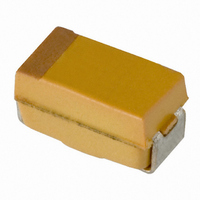TAJA225K006RNJ AVX Corporation, TAJA225K006RNJ Datasheet - Page 11

TAJA225K006RNJ
Manufacturer Part Number
TAJA225K006RNJ
Description
CAP TANT 2.2UF 6.3V 10% SMD
Manufacturer
AVX Corporation
Series
TAJr
Type
Moldedr
Specifications of TAJA225K006RNJ
Capacitance
2.2µF
Package / Case
1206 (3216 Metric)
Voltage - Rated
6.3V
Tolerance
±10%
Operating Temperature
-55°C ~ 125°C
Mounting Type
Surface Mount
Size / Dimension
0.126" L x 0.063" W (3.20mm x 1.60mm)
Height
0.063" (1.60mm)
Manufacturer Size Code
A
Features
General Purpose
Tolerance (+ Or -)
10%
Voltage
6.3VDC
Esr
9Ohm
Mounting Style
Surface Mount
Polarity
Polar
Construction
SMT Chip
Case Style
Molded
Case Code
A
Lead Spacing (nom)
Not Requiredmm
Df
6%
Dcl
0.5uA
Seal
Not Required
Insulation
Not Required
Failure Rate
Not Required
Wire Form
Not Required
Product Length (mm)
3.2mm
Product Height (mm)
1.6mm
Product Depth (mm)
1.6mm
Product Diameter (mm)
Not Requiredmm
Seated Plane Height
Not Requiredmm
Length W/weld (max)
Not Requiredmm
Operating Temp Range
-55C to 125C
Lead Free Status / RoHS Status
Lead free / RoHS Compliant
Lead Spacing
-
Esr (equivalent Series Resistance)
-
Lead Free Status / RoHS Status
Compliant, Lead free / RoHS Compliant
Other names
TAJA225K006R
TAJA225K006R
TAJA225K006R
Technical Summary and
Application Guidelines
1.3.2 Tangent of Loss Angle (tan ).
This is a measurement of the energy loss in the capacitor. It
is expressed as tan
divided by its reactive power at a sinusoidal voltage of spec-
ified frequency. Terms also used are power factor, loss factor
and dielectric loss. Cos (90 - ) is the true power factor. The
measurement of tan
bridge which supplies a 0.5Vpk-pk 120Hz sinusoidal signal,
free of harmonics with a maximum bias of 2.2Vdc.
1.3.3 Frequency dependence of Dissipation Factor.
Dissipation Factor increases with frequency as shown in the
typical curves:
1.3.4 Temperature dependence of Dissipation
Dissipation factor varies with temperature as the typical curves
show. For maximum limits please refer to ratings tables.
1.4 IMPEDANCE, (Z) AND EQUIVALENT
1.4.1 Impedance, Z.
This is the ratio of voltage to current at a specified frequency.
Three factors contribute to the impedance of a tantalum capac-
itor; the resistance of the semiconductor layer; the capacitance
value and the inductance of the electrodes and leads.
At high frequencies the inductance of the leads becomes
a limiting factor. The temperature and frequency behavior
of these three factors of impedance determine the behavior
0.1
50
1.8
1.7
1.6
1.5
1.4
1.3
1.2
1.1
0.9
0.8
5
1
0.1
1
-55
SERIES RESISTANCE (ESR)
Factor.
Typical DF vs Temperature
Typical DF vs Frequency
-5
Temperature (Celcius)
1
and is the power loss of the capacitor
Frequency (kHz)
is carried out using a measuring
45
10
95
100
of the impedance Z. The impedance is measured at 20°C
and 100kHz.
1.4.2 Equivalent Series Resistance, ESR.
Resistance losses occur in all practical forms of capacitors.
These are made up from several different mechanisms,
including resistance in components and contacts, viscous
forces within the dielectric and defects producing bypass
current paths. To express the effect of these losses they are
considered as the ESR of the capacitor. The ESR is frequency
dependent and can be found by using the relationship;
Where f is the frequency in Hz, and C is the capacitance in
farads.
The ESR is measured at 20°C and 100kHz.
ESR is one of the contributing factors to impedance, and
at high frequencies (100kHz and above) it becomes the
dominant factor. Thus ESR and impedance become almost
identical, impedance being only marginally higher.
1.4.3 Frequency dependence of Impedance and ESR.
ESR and Impedance both increase with decreasing frequency.
At lower frequencies the values diverge as the extra contri-
butions to impedance (due to the reactance of the capacitor)
become more significant. Beyond 1MHz (and beyond the
resonant point of the capacitor) impedance again increases
due to the inductance of the capacitor.
100
0.1
4.5
3.5
2.5
1.5
0.5
10
1
5
4
3
2
1
0
0.1
0.1
Typical Impedance vs Frequency
Typical ESR vs Frequency
ESR =
1
1
Frequency (kHz)
Frequency (kHz)
tan
2 fC
10
10
100
100
1000
1000
39











